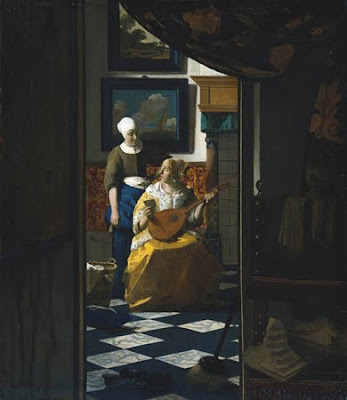Sunday, January 31, 2010
Wayne Thiebaud
Saturday, January 23, 2010
Hypocrite and Slanderer

Saturday, October 31, 2009
Mary Heilmann: Tell, don't Ask
More links:
Monday, October 26, 2009
Helen Frankenthaler's woodcuts

| Radius 1993 |
| colour woodcut printed from six woodblocks on hand-coloured paper |
Friday, September 4, 2009
Thursday, August 20, 2009
Vermeer in Vancouver, but not for long!

Here's a coincidence: just this morning I posted about my own painting called Love Letter (To Mondrian) on my website journal. I had no idea Vermeer's image would pop up when I googled the show in British Columbia...
Perhaps love is in the air?
--------
Monday, August 3, 2009
Ignore Everybody
Ice drawings and hamburgers

Wednesday, July 29, 2009
Rembrandt's Nose

1659
84.4 x 66 cm.
National Gallery of Art, Washington
Monday, July 27, 2009
Bauhaus in Berlin: Coming to NY

Saturday, July 25, 2009
"Re-": Cardboard sculpture


Through August 27
1402 Third Ave,
Fifth Floor, Suite 500
Seattle, WA
206-447-1880 ext. 100
-----------
After viewing the art, you are invited to respond to the question:
“What thoughts about sustainability are inspired by
Bryan's art (and by art in general)?”
A notebook to share your response is available near the artwork,
or you can add your comment here.
Sunday, July 12, 2009
Sketching in Tokyo, Florence, Sao Paulo, Paris, Seattle...
Saturday, July 4, 2009
A tale of independence

Oil on wood
60.3 x 46.6 cm (23 3/4 x 18 3/8 in.)
Detroit Institute of Arts
Thursday, June 25, 2009
Up close - really close - at the Prado
Below is a short video of the making of the images and how the feature looks in Google Earth (for a larger image, watch it here).
Tuesday, June 16, 2009
Sunday studio

Public art
Sometimes a joyful antic is in order. This video was made in Antwerp, Belgium's Central Station on March 23, 2009. |
At 8:00am, with no warning to the passengers passing through the station, a recording of Julie Andrews singing 'Do, Re, Mi' begins to play on the public address system. As the surprised travelers look on, some 200 dancers begin to appear from the crowd and station entrances. They created the performance with just two rehearsals.
Saturday, June 13, 2009
Michael Matisse for Team Seattle

Solo show downtown through June
Sightline Institute
Through the month of June
Julia Hensley
Thursday, June 11, 2009
Book review: Art, chess and murder

Wednesday, June 10, 2009
Surprises
On Sunday, Sue Danielson, Joan Cox, Peter and Jillian Hensley and I sat around my long table spread with books and postcards that related, obviously or obliquely, to narrative in art, drinking coffee and munching carrot cake. From the get-go, the ideas just flew.

One of my favorite moments was when Jillian wondered aloud how the all-white painting she once saw in a museum many years ago could possibly contain a story. She found the piece annoying in its blankness, so carefully and evenly painted, and couldn't see how it amounted to anything.
After some discussion she surprised herself by musing that for one thing, perhaps the reason she saw only white was because she had zoomed in so far the subject couldn't be made out, and that if she could only draw back a bit it would begin to reappear...this imagining, she suprised herself further by realizing, created in effect a kind of content, and a story.
The eyes of the artists in the room glistened at the recognition of a potentially mineable idea. You could almost hear the little gray cells expanding, along with our definition of narrative.
But before we got much further down that road, Peter began to express his experience of abstract art - a Mondrian grid painting, for example - as "arresting" his eye and further, his thoughts, because it presents no imagery that can be immediately interpreted. Thus for him, a purely abstract painting effectively interrupts the mind's search for a narrative. Aha. A view, then, in support of abstract art as non-narrative? Joni for one found this idea particularly compelling as a sort of Buddhist approach that enabled her to see the contrast between story and, at least initially, no story.
More expansion. More coffee.
We continued, engrossed, nibbling spanokopita and mushroom turnovers. I held up Mondrian and Velazquez, Asterix and Jacob Lawrence, and we followed our thoughts out loud, ultimately deciding, after three hours, that we had barely scratched the surface. A most satisfying Cafe. Thanks to all who were there.
Wish you had been? Look for Part Two of this topic, I have a feeling it will be back. Comments, thoughts? Post here or Email me.
Suprematist Composition: White on White
Kazimir Malevich (Russian, born Ukraine. 1878-1935)

